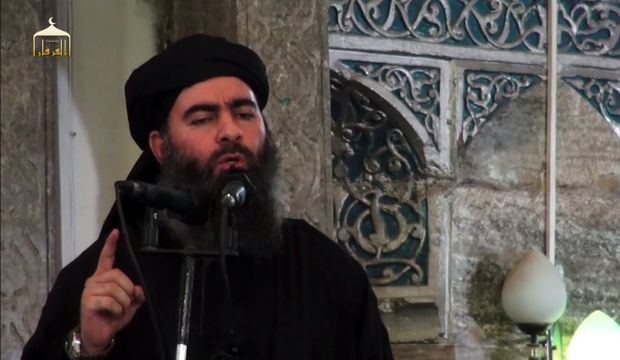
An image from a propaganda video by Al-Furqan Media allegedly shows the leader of the ISIS Abu Bakr Al-Baghdadi on July 5, 2014 (AFP PHOTO / HO / AL-FURQAN MEDIA)
Erbil, Asharq Al-Awsat—Cracks are appearing within the Islamic State of Iraq and Syria (ISIS) amid reports of divisions and confrontation between foreign fighters and local tribesmen in the Iraqi provinces of Nineveh, Salah Al-Din and Anbar.
The divisions have emerged over ISIS’s execution of its governor, or Wali, of Tel Afar, with clashes subsequently erupting between ISIS fighters in Mosul and those in Tel Afar.
Patriotic Union of Kurdistan (PUK) spokesman for Nineveh Hawkar Jaff told Asharq Al-Awsat: “We have seen battles between the Tel Afar fighters and the Arabs and Iraqi fighters, with each side utilizing mortars against the others.”
“The Tel Afar fighters have now defected from ISIS,” he added.
Jaff revealed that Tel Afar’s fighters are predominately local Iraqis, as well as a group of foreign fighters from Tunisia who remain loyal to Wali Abdulrahman Al-Afghani.
“Battles erupted between Tel Afarite ISIS fighters and Mosulite ISIS fighters during a meeting in the Hammam Al-Alil area south of Mosul over the issue of the allocation of funds,” Kurdistan Democratic Party (KDP) official Saeed Mamozeini told Asharq Al-Awsat.
Mamozeini, who is director of the KDP’s media bureau in Nineveh governorate, said that 15 ISIS fighters had been killed in the initial clashes, adding that the fighting is ongoing.
Another KDP official, Ghayath Sawraji, said that divisions and violence between ISIS fighters is not uncommon.
He told Asharq Al-Awsat: “There is violence between armed ISIS fighters in Mosul every now and then, with many people dying as a result of internal conflicts within the group. The reasons for this are varied and include fighting over war booty [including slaves], as well as differences of opinion over issues relating to fighting and hostages.”
“There are also conflicts between different ISIS leaders and their supporters, as well as other conflict between foreign fighters and local Arab and Iraqi fighters,” he added.
Local sources also told Asharq Al-Awsat that the brutal execution of Jordanian pilot Moaz Al-Kasasbeh, who was burnt alive, has been far from the propaganda victory that ISIS envisioned.
“There have been splits within ISIS’s main command after many members objected to the execution of the Jordanian pilot and the manner in which the group is dealing with hostages and prisoners of war,” Anbar tribal Shiekh Fahdan Al-Sadid said.
A leading member of the powerful Shammar tribe, Sadid called for greater cooperation and coordination between the US-led international anti-ISIS coalition and local Sunni forces on the ground. “This is ISIS’s greatest fear,” he said.
Sadid stressed that while ISIS had managed to incorporate smaller extremist and terrorist groups such as the Al-Qaeda-affiliated Al-Tawhid wal-Jihad and others, these groups are now straying from ISIS rule.
“More than 60 percent of such groups are no longer as convinced by ISIS and are now actively leaving the group, particularly after they lost some territory in Iraq and preparations are underway for a major military offensive to drive ISIS out of the country,” he added.
Additional reporting by Manaf Al-Obeidi from Anbar.
